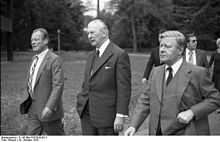Grand coalition (Germany)
In modern Germany, grand coalition (German: Große Koalition) describes a governing coalition of the Christian Democrats (CDU together with the Bavarian CSU) and the Social Democrats, as they are the two largest parties.
Weimar Republic
In the Weimar Republic of 1919–1933, the term "grand coalition" was used for a coalition that included the Social Democratic Party, SPD, the Catholic Centre Party and the liberal parties Democratic Party, DDP and People's Party, DVP. Such a coalition was in power in 1923 and in 1928–1930, although the latter was a conglomerate of parties with somewhat conflicting interests, that banded together to as a safeguard for democracy against the radical political parties, the KPD and the NSDAP.
Federal Republic

In the post-war politics of Germany, three grand coalitions (Große Koalition) have been formed at the national level. Germany has historically tended to favor narrow coalitions between parties with closer natural alignments, such as SPD–FDP, SPD–Green or CDU/CSU–FDP coalitions. A grand coalition would be likely only if one of these natural alignments broke down, or if far left or far right parties were to secure significant representation in the Bundestag.
Kiesinger cabinet
On 1 December 1966, the government was formed by the Social Democratic Party of Germany and the Christian Democratic Union of Germany, the two major political parties in the Federal Republic of Germany. It was the result of arguments about tax increases between the CDU/CSU–FDP coalition of the time. The FDP ministers stood down and a new government was formed with the SPD under Kurt Georg Kiesinger of the CDU. The grand coalition was in control of 95% of the Bundestag, leaving many politically active students disillusioned; this disillusionment led to the formation of the Außerparlamentarische Opposition which formed a core of the German student movement. The Kiesinger grand coalition lasted until 1969.
Merkel cabinets I and III
After the inconclusive result of the 2005 German federal election, neither of the traditional coalitions could form a majority government. An ideologically coherent coalition existed on the left, comprising the SPD, Greens, and the Left Party, but a desire to exclude the Left Party from government (i.e. a cordon sanitaire) led the leaders of the SPD and the CDU/CSU to agree to form a grand coalition with CDU leader Angela Merkel as chancellor and an equal number of cabinet seats for each party. The chancellor was elected on 22 November, and the first Merkel Cabinet took office.
The second grand coalition ended when after the 2009 federal election Angela Merkel on 28 October, was re-elected by CDU/CSU and FDP Bundestag MPs and formed the second Merkel Cabinet.
Following the 2013 election, a third grand coalition was formed by SPD and CDU/CSU on 27 November 2013.[1] Again it had been possible to form a SPD–Greens–Left government, but a grand coalition was formed instead. The coalition has been nicknamed GroKo (shortening for Große Koalition) which was named 2013 word of the year in Germany.[2]
State level
Grand coalitions are more common at the state level in Germany, because other parties might be stronger there than they are on the federal level. For example in several East German states, the party Die Linke often makes it difficult to form a coalition of SPD and Greens or CDU and FDP. As of November 2011, Berlin, Mecklenburg-Western Pomerania, Saxony-Anhalt and Thuringia are governed by coalitions between the CDU and the SPD.
See also
- Historic Compromise (Italy)
References
- ↑ Smale and Eddy (27 November 2013) German Rivals Reach Pact for Coalition Government New York Times'. Retrieved 13 December 2013
- ↑ (German) GroKo" ist das Wort des Jahres 2013 Die Welt. Retrieved 13 December 2013
Further reading
- Helms, Ludger (2006). "The Grand Coalition: Precedents and Prospects". German Politics and Society 24 (1): 47–66. doi:10.3167/104503006780935234.